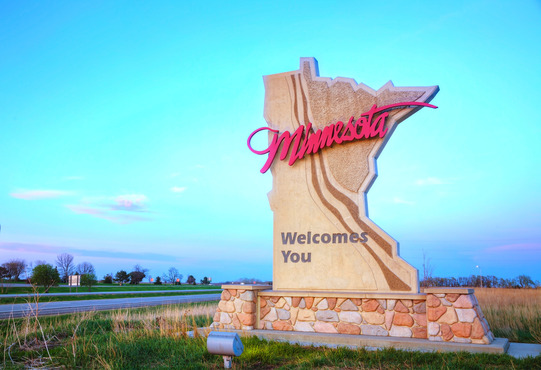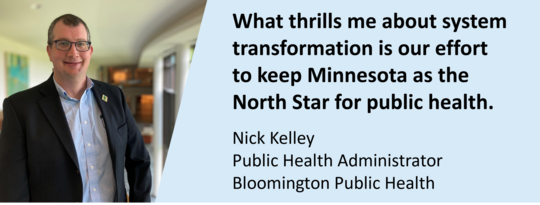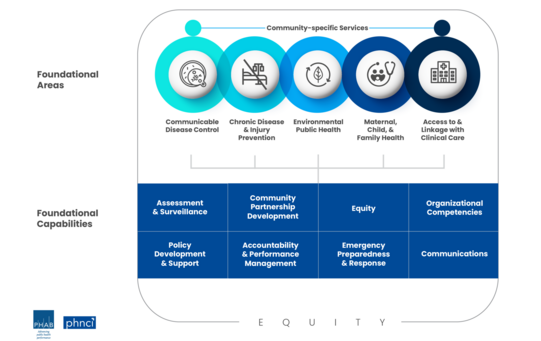|
Public Health
System Transformation Update
A monthly update from the Joint Leadership Team sharing how, together, we're creating a seamless, responsive, publicly-supported public health system in Minnesota

|
|
|
View this as a webpage
When we think of what it means to “transform” Minnesota’s public health system, we each picture what that means to us and our communities, along with our specific part in it and how our work fits into the whole.
As a Joint Leadership Team, when we picture a transformed public health system, we envision a seamless, responsive, publicly-supported public health system that works closely with the community to ensure healthy, safe, and vibrant communities. This system of state, local, and tribal health departments will help Minnesotans be healthy regardless of where they live.
We heard you ask for more consistent and transparent communication about Minnesota’s work to transform, strengthen, and update the governmental public health system, and we understand. We all do better when we know who’s at the table, what’s going on at any given time, and where we’re headed together in the future.
This regular newsletter is one part of a more transparent communication strategy from the Joint Leadership Team. In the future, the Joint Leadership Team will also share more and different updates, including an FAQ of your frequently asked questions.
If you’d like to reach out to the Joint Leadership Team at any time, we’d love to hear from you. Please read on to learn how we’re all working together to update our public health system to be more seamless, responsive, and publicly-supported.
Thank you!
— The Joint Leadership Team for Public Health System Transformation in Minnesota

|
|
What does system transformation mean to you?
 What thrills me about system transformation work is our effort to keep Minnesota as the North Star for public health—but, again, it’s a North Star for some and not for others, and that’s not acceptable.
Transforming the public health system can help us address the structural issues that undermine our current system as it was designed: building partnerships we need to reduce health disparities, meeting the realities of the 21st century, and recognizing all of the partners that make up our public health system in Minnesota. I’m thrilled I get to play a small part in changing that system to be a more true North Star.
Last month, Joint Leadership Team Member Nick Kelly, Public Health Administrator for Bloomington Public Health, shared his vision and personal inspirations in our inaugural newsletter. Read the full column at: March 2024: Inaugural Newsletter.
|
|
Do you see examples of a seamless, responsive, publicly-supported public health system in your community? Let us know! |
|
What are foundational responsibilities?
Where you live should not determine your level of public health protection. All Minnesotans should have access to comprehensive, high-quality public health, but our system is well-resourced in some programs, topics, and communities, and less so in others.
The foundational responsibilities (below) consist of the population-level activities unique to governmental public health. The responsibilities are divided into five topic areas and eight capabilities, all encircled by equity. These responsibilities should be in place everywhere for public health to work anywhere in Minnesota.
Foundational public health responsibilities
 How these responsibilities are carried out will look different depending on local context. Health departments will also provide additional services beyond the foundational responsibilities, as they always have, and may require more or less capacity in different areas and capabilities to best serve their communities.
The whole governmental public health system in Minnesota has a collective responsibility to Minnesotans’ health, and working together to meet foundational responsibilities can equip the statewide system for collective success.
Learn more: Foundational Public Health Responsibilities and Framework.
|
|
|
Public health partners across Minnesota, at the state, local, tribal, and community level, are working together to answer: What would it look like for Minnesota to fulfill the foundational public health responsibilities?
Here are some of the ways we’re finding answers, together:
-
MDH and local public health agencies are using data from the 2022 system “cost and capacity assessment” to consider opportunities and challenges for doing foundational work locally and regionally, as discussed in this webinar and Q&A recorded earlier this month.
-
To fulfill foundational responsibilities across the system, accountability and transparency are grounded in clear goals and measurement: The SCHSAC Performance Measurement Workgroup is considering how to measure the entire system’s performance by looking at data, monitoring progress, and reporting on trends that indicate opportunities for improvement. The brand new SCHSAC Foundational Public Health Responsibilities Workgroup will recruit members and begin meeting later this spring, to help the system determine the minimum standards for full implementation, locally and system-wide.
-
Work to strengthen tribal public health moves in parallel to state and local activities: As sovereign nations with their own public health authority, many of the tribal nations Minnesota shares geography with are also assessing their public health infrastructure against national standards, and considering what it looks like to strengthen their work and build capacity to meet their needs.
-
The Minnesota Infrastructure Fund is supporting a second round of locally-led, two-year innovation projects, testing new ways of doing foundational public health work that could be used across the state—locally, regionally, or statewide.
 |
|
TV/online: The Invisible Shield (PBS): This four-part documentary series, reveals a little-known truth: that public health saved your life today and you probably don’t even know it. But while public health makes modern life possible, the work itself is often underfunded, undervalued, and misunderstood. |
Please note: The views expressed in these resources are those of the specific authors and organizations creating these resources, and do not necessarily reflect those of the Joint Leadership Team, its members, or its represented sectors.
|
|
What is the Joint Leadership Team?
Three sectors in Minnesota work together to guide the work of transforming Minnesota's public health system, determining what it looks like when a system is equitable and has adequate resources.
This Joint Leadership Team consists of people from: SCHSAC (State Community Health Services Advisory Committee), LPHA (Local Public Health Association of Minnesota), and MDH (Minnesota Department of Health).
Learn more: Joint Leadership Team and Subgroups.
|
|
Contact a specific member of the Joint Leadership Team
Based on the collaborative nature of this work, please direct any questions or feedback to one of the following.
-
Local public health staff and leadership: Please contact your LPHA representatives currently serving on the joint leadership team.
-
MDH staff and leadership: Please contact the MDH staff currently serving on the joint leadership team.
-
SCHSAC members and alternates: Please contact the SCHSAC representatives currently serving on the joint leadership team.
General questions
For general questions, including about funding, grants, and eligible activities: Please contact the MDH Center for Public Health Practice at health.ophp@state.mn.us.
Not sure who to contact?
Visit Ask a Question: Transforming the Public Health System in Minnesota. Joint Leadership Team members review these questions on a regular basis and respond as needed or requested.
|
|
|
|
|